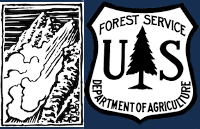Snowpack and Avalanche Discussion
<h3><span><span><span><strong><span><span>GENERAL SPRING SNOWPACK AND TRAVEL ADVICE</span></span></strong></span></span></span></h3>
<p><span><span><span><span><span><span>NEW SNOW AND WIND LOADED SLOPES</span></span></span></span></span></span></p>
<p><span><span><span><span><span><span>Spring storms are notorious for depositing heavy amounts of snow in the mountains. Even with a deep and generally stable snowpack throughout the advisory area, heavy and rapid loads of new snow will decrease stability. The main problems to look out for are avalanches breaking within the new snow, wind slabs, and loose snow avalanches. The likelihood of triggering an avalanche spikes during and immediately after snowstorms. New snow instabilities tend to stabilize quickly, but it’s a good idea to give fresh snow a day to adjust before hitting big terrain. New snow instabilities can be challenging to assess, and spring storms bond to old snow differently across aspects and elevations. Conservative terrain selection is essential during and immediately following storms. Avoid wind-loaded slopes and slopes steeper than 35 degrees for 24-48 hours after new snow and wind.</span></span></span></span></span></span></p>
<p><span><span><span><span><span><span>New snow can quickly change from dry to wet on a spring day, and stability can decrease rapidly with above freezing temperatures or brief sunshine. New snow may bond well early in the morning and then easily slide later. Wet loose slides are likely during the first above freezing temperatures or sunshine immediately after a storm. Anticipate changes in snow stability as you change aspect or elevation and over the course of the day. An early start is always an advantage. Be ready to change plans or move to safer terrain at the first signs of decreasing stability.</span></span></span></span></span></span></p>
<p><span><span><span><span><span><span>WET SNOW AVALANCHES</span></span></span></span></span></span></p>
<p><span><span><span><span><span><span>Spring and wet snow avalanches go hand-in-hand. Above freezing temperatures, rain, and/or intense sunshine cause the snow to become wet and weak and make wet avalanches easy to trigger or release naturally. Conditions tend to become most unstable when temperatures stay above freezing for multiple days and nights in a row. Avoid steep terrain, and be aware of the potential for natural wet avalanches in steep terrain above you, if you see:</span></span></span></span></span></span></p>
<ul>
<li><span><span><span><span><span><span>Heavy rain,</span></span></span></span></span></span></li>
<li><span><span><span><span><span><span>Above freezing temperatures for more than 24 hours,</span></span></span></span></span></span></li>
<li><span><span><span><span><span><span>Natural wet avalanches,</span></span></span></span></span></span></li>
<li><span><span><span><span><span><span>Rollerballs or pinwheels indicating a moist or wet snow surface,</span></span></span></span></span></span></li>
<li><span><span><span><span><span><span>Or if you sink to your boot top in wet snow.</span></span></span></span></span></span></li>
</ul>
<p><span><span><span><span><span><span>In general, if the snow surface freezes solid overnight, the snowpack will be stable in the morning and stability will decrease through the day as snow warms up. The snow surface hardness, rate of warming, duration of sunshine, aspect and elevation determine how fast stability will decrease through the day. Be aware that sunny aspects may have a wet snow avalanche danger while shadier slopes still have a dry snow avalanche danger. Getting off of steep slopes should be considered when, or before, the above signs of instability are present. Wet snow avalanches, whether loose snow or slabs, can be powerful, destructive and very dangerous. Conservative terrain choices, starting early in the day, and careful observations can keep you safe.</span></span></span></span></span></span></p>
<p><span><span><span><span><span><span>CORNICES</span></span></span></span></span></span></p>
<p><span><span><span><span><span><span>Cornices along ridgelines are massive and can break under the weight of a person (photo). Prolonged above freezing temperatures and rain make them weaker and possible to break naturally. They can break off suddenly and farther back than one might expect. Cornice falls can also entrain large amounts of loose snow or trigger slab avalanches. Stay far back from the edge of ridgelines and minimize exposure to slopes directly below cornices. Regardless of whether a cornice triggers a slide or not, a falling cornice is dangerous to anyone in its path.</span></span></span></span></span></span></p>
<p><span><span><span><span><span><span>DISCLAIMER</span></span></span></span></span></span></p>
<p><span><span><span><span><span><span>It does not matter if new snow falls or not, avalanches will continue to occur until the existing snowpack is mostly gone. Always assess the slope you plan to ride with diligence and safety in mind. Do not let your guard down. Travel with a partner, carry rescue gear and only expose one person at a time in avalanche terrain.</span></span></span></span></span></span></p>
<p><span><span><span><span><span><span>Have a safe and enjoyable spring and summer!</span></span></span></span></span></span></p>
<p><span><span><span><span><span><span>Mark, Alex, Ian and Dave</span></span></span></span></span></span></p>
<p><span><span><span><span><span><span>For more spring travel advice see this </span></span></span></span></span></span><a href="https://www.mtavalanche.com/blog/transitions-spring-snow-avalanche-prob… our GNFAC forecaster blog.</span></span></span></span></span></span></p>
<p><span><span><span><span><span><span>We will continue to share avalanche and snowpack information on our website and social media when available. </span></span></span></span></span></span><span><span><span><span><span><span>If you get out, please send us your observations no matter how brief. </span></span></span></span></span></span><span><span><span><span><span><span>Submit them via our </span></span></span></span></span></span><a href="https://www.mtavalanche.com/node/add/snow_observation"><span><span><spa…; or email </span></span></span></span></span></span><a href="mailto:mtavalanche@gmail.com"><span><span><span><strong><span><u><span>…;
